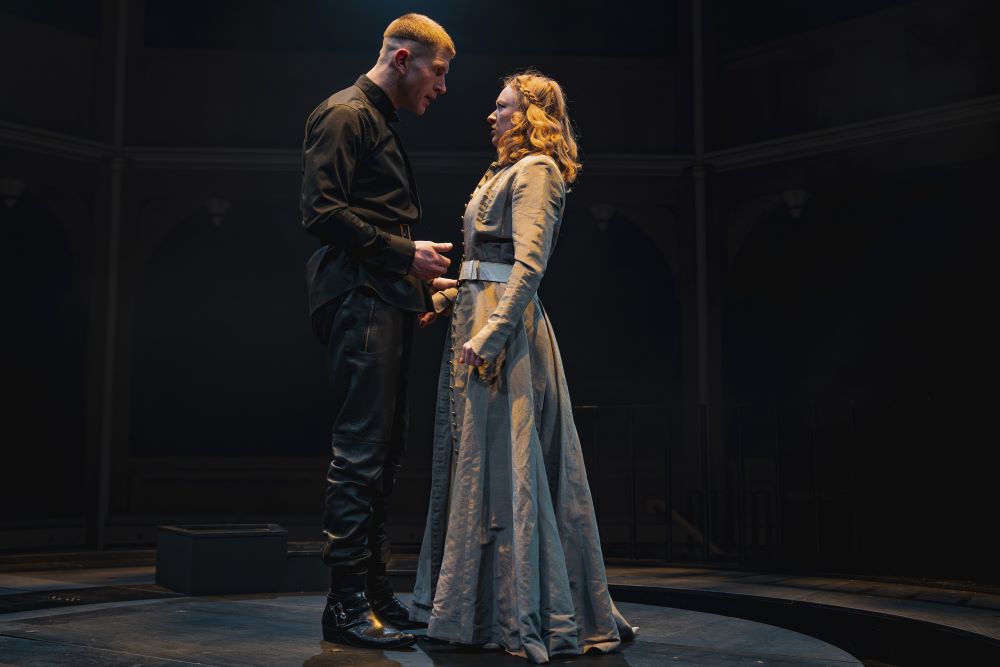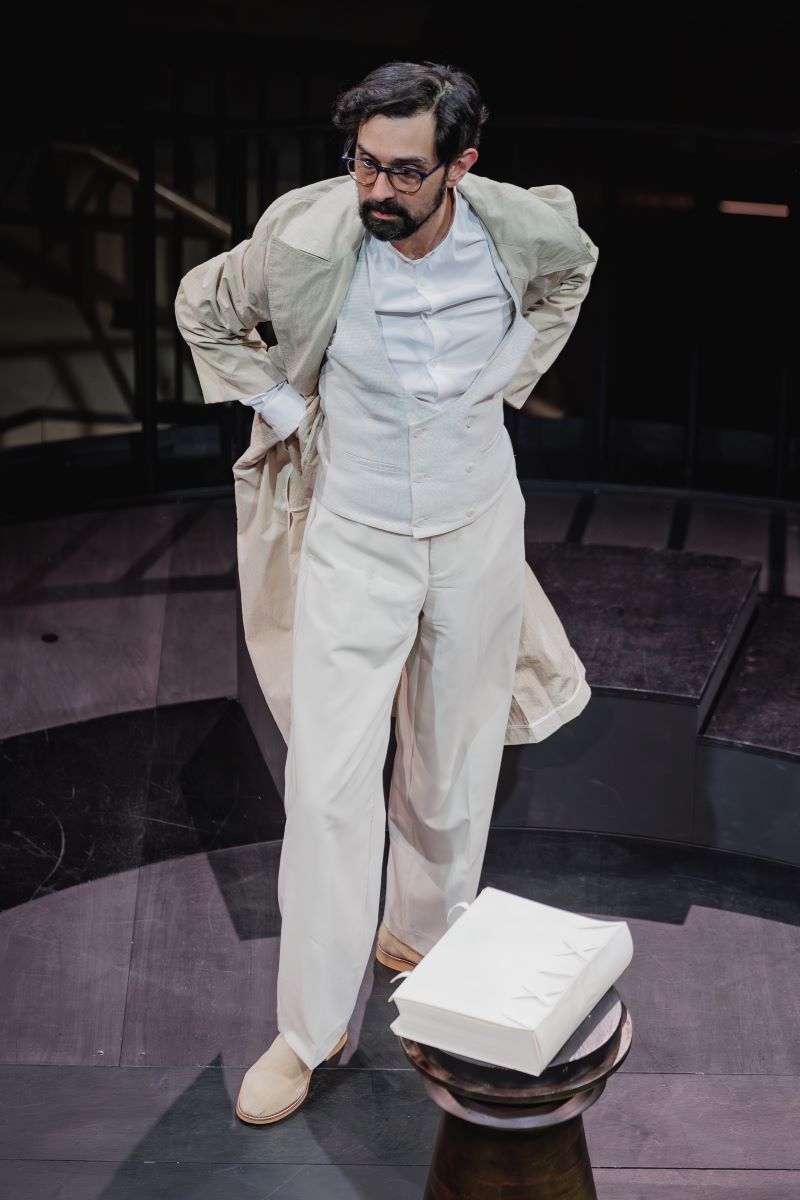Richard, My Richard, Theatre Royal Bury St Edmund's review - too much history, not enough drama | reviews, news & interviews
Richard, My Richard, Theatre Royal Bury St Edmund's review - too much history, not enough drama
Richard, My Richard, Theatre Royal Bury St Edmund's review - too much history, not enough drama
Philippa Gregory’s first play tries to exonerate Richard III, with mixed results

History is very present in Philippa Gregory’s new play about Richard III. Literally - History is a character, played by Tom Kanji. He strides around in a pale trenchcoat, at first rather too glib and pleased with himself, but quickly sucked into the action as Richard’s life plays out in front of him. If only Katie Posner’s production, which started at Shakespeare North Playhouse and is now at the Theatre Royal Bury St Edmund’s, could draw us in so powerfully.
The blurb describes “an explosion of tarmac” as Richard III bursts into the modern day in a Leicester car park, but Kyle Rowe’s entrance is less bombastic. He pulls himself out of the bowels of the stage, a muscular Yorkshireman with a haircut that occupies the middle of the Venn diagram between medieval king and aspiring England footballer. His performance is solid and likeable; he’s more of a tragic hero than a villain, not driven by evil intent but trapped by circumstance.
You find yourself rooting for Richard and his wife, Anne Neville (Tori Burgess, pictured below, with Rowe). Their first scene together parallels the one in Shakespeare’s Richard III, but emphasises their childhood friendship and suggests that the marriage was Anne’s idea, not Richard forcing himself upon her. Here and at other points, Richard, My Richard feels like a screw-you to Shakespeare. But it’s also a nuanced retelling of Richard’s life, and Gregory doesn’t grant enough time to either concept to fully flesh them out. The result is chaotic, too fast in some scenes and too slow in others. The cast do well with a script in iambic pentameter, which boxes them into unnatural configurations. And did people really spend so much time telling each other their family mottos?  Richard Kent’s design, by contrast, is simple but elegant: a bare black circle with two sets of steps. At its centre is what appears to be a giant USB port but is actually a stool shaped like a chess piece, moved around and sat upon. The costume design is pared back as well, a medieval-modern fusion, with lots of leather trousers and swirling gowns (which don’t count as history, according to History; shows what he knows). There’s a poignant moment towards the end when History straps on Richard’s armour for him, ready for his last stand.
Richard Kent’s design, by contrast, is simple but elegant: a bare black circle with two sets of steps. At its centre is what appears to be a giant USB port but is actually a stool shaped like a chess piece, moved around and sat upon. The costume design is pared back as well, a medieval-modern fusion, with lots of leather trousers and swirling gowns (which don’t count as history, according to History; shows what he knows). There’s a poignant moment towards the end when History straps on Richard’s armour for him, ready for his last stand.
Not many plays have a family tree in the programme, but this one definitely needs it. The absurdity of the extended family drama that was the Wars of the Roses is highlighted by a clever dance-and-rhyme sequence. There’s a lot of Very Loud Exposition. “We wouldn’t be Plantagenets if we weren’t completely merciless,” announces Richard’s brother Edward IV, before stabbing the former king (and his own cousin) Henry VI to death in his bed. Can’t say he didn’t warn us.
 The decision to have History played by a man is a strange one, given that history is mostly about remembering things and writing them down, which women are socialised to do and men are not (Tom Kanji, pictured right). History is admin, and admin is largely done by women. But Gregory and Posner have brought women to the fore in other ways. Where the play is dominated at first by Richard and History, and then by the three noisy sons of York, later it becomes all about the women. This is in keeping with Gregory’s historical novels, also centred on the women of the Wars of the Roses. But it’s a shame that she leans so hard into the belief that Edward’s wife Elizabeth Woodville could control the weather and lay curses on her enemies. Resorting to accusations of witchcraft to explain away a woman’s ambition strikes me as rather medieval.
The decision to have History played by a man is a strange one, given that history is mostly about remembering things and writing them down, which women are socialised to do and men are not (Tom Kanji, pictured right). History is admin, and admin is largely done by women. But Gregory and Posner have brought women to the fore in other ways. Where the play is dominated at first by Richard and History, and then by the three noisy sons of York, later it becomes all about the women. This is in keeping with Gregory’s historical novels, also centred on the women of the Wars of the Roses. But it’s a shame that she leans so hard into the belief that Edward’s wife Elizabeth Woodville could control the weather and lay curses on her enemies. Resorting to accusations of witchcraft to explain away a woman’s ambition strikes me as rather medieval.
Surely this production is heading to Leicester or York, where it will have home advantage. It’s a diverting two and a half hours, but it tends towards the didactic. “Time for a history lesson,” says History, about 20 minutes into a history lesson.
This exposes a broader issue: Gregory can’t seem to decide whether she wants History to represent the academic discipline, the popular idea of what historians do, or the written record of what we believe happened in the past. History the character contradicts himself; he goes with what he thinks is the logical course of events rather than what Richard is telling him. Talk about ignoring your primary sources.
rating
Explore topics
Share this article
The future of Arts Journalism
You can stop theartsdesk.com closing!
We urgently need financing to survive. Our fundraising drive has thus far raised £49,000 but we need to reach £100,000 or we will be forced to close. Please contribute here: https://gofund.me/c3f6033d
And if you can forward this information to anyone who might assist, we’d be grateful.

Subscribe to theartsdesk.com
Thank you for continuing to read our work on theartsdesk.com. For unlimited access to every article in its entirety, including our archive of more than 15,000 pieces, we're asking for £5 per month or £40 per year. We feel it's a very good deal, and hope you do too.
To take a subscription now simply click here.
And if you're looking for that extra gift for a friend or family member, why not treat them to a theartsdesk.com gift subscription?
more Theatre
 Troilus and Cressida, Globe Theatre review - a 'problem play' with added problems
Raucous and carnivalesque, but also ugly and incomprehensible
Troilus and Cressida, Globe Theatre review - a 'problem play' with added problems
Raucous and carnivalesque, but also ugly and incomprehensible
 Clarkston, Trafalgar Theatre review - two lads on a road to nowhere
Netflix star, Joe Locke, is the selling point of a production that needs one
Clarkston, Trafalgar Theatre review - two lads on a road to nowhere
Netflix star, Joe Locke, is the selling point of a production that needs one
 Ghost Stories, Peacock Theatre review - spirited staging but short on scares
Impressive spectacle saves an ageing show in an unsuitable venue
Ghost Stories, Peacock Theatre review - spirited staging but short on scares
Impressive spectacle saves an ageing show in an unsuitable venue
 Hamlet, National Theatre review - turning tragedy to comedy is no joke
Hiran Abeyeskera’s childlike prince falls flat in a mixed production
Hamlet, National Theatre review - turning tragedy to comedy is no joke
Hiran Abeyeskera’s childlike prince falls flat in a mixed production
 Rohtko, Barbican review - postmodern meditation on fake and authentic art is less than the sum of its parts
Łukasz Twarkowski's production dazzles without illuminating
Rohtko, Barbican review - postmodern meditation on fake and authentic art is less than the sum of its parts
Łukasz Twarkowski's production dazzles without illuminating
 Lee, Park Theatre review - Lee Krasner looks back on her life as an artist
Informative and interesting, the play's format limits its potential
Lee, Park Theatre review - Lee Krasner looks back on her life as an artist
Informative and interesting, the play's format limits its potential
 Measure for Measure, RSC, Stratford review - 'problem play' has no problem with relevance
Shakespeare, in this adaptation, is at his most perceptive
Measure for Measure, RSC, Stratford review - 'problem play' has no problem with relevance
Shakespeare, in this adaptation, is at his most perceptive
 The Importance of Being Earnest, Noël Coward Theatre review - dazzling and delightful queer fest
West End transfer of National Theatre hit stars Stephen Fry and Olly Alexander
The Importance of Being Earnest, Noël Coward Theatre review - dazzling and delightful queer fest
West End transfer of National Theatre hit stars Stephen Fry and Olly Alexander
 Get Down Tonight, Charing Cross Theatre review - glitz and hits from the 70s
If you love the songs of KC and the Sunshine Band, Please Do Go!
Get Down Tonight, Charing Cross Theatre review - glitz and hits from the 70s
If you love the songs of KC and the Sunshine Band, Please Do Go!
 Punch, Apollo Theatre review - powerful play about the strength of redemption
James Graham's play transfixes the audience at every stage
Punch, Apollo Theatre review - powerful play about the strength of redemption
James Graham's play transfixes the audience at every stage
 The Billionaire Inside Your Head, Hampstead Theatre review - a map of a man with OCD
Will Lord's promising debut burdens a fine cast with too much dialogue
The Billionaire Inside Your Head, Hampstead Theatre review - a map of a man with OCD
Will Lord's promising debut burdens a fine cast with too much dialogue

Add comment